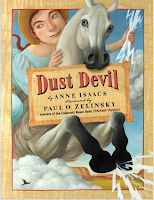Sidman,
Joyce. This is Just to Say: Poems of Apology and Forgiveness.
Ill. by Pamela Zagarenski. New York: Houghton Mifflin. 2007. ISBN 9780618616800
B. Plot Summary
The book, This is Just to Say, written by a sixth grade class is based on a
poem by William Carlos, “This is Just to Say”.
Mrs. Merz, a sixth grade teacher, has commissioned her class to write
apology poetry to someone they need to apologize to. Editor Anthony K, thought it was a good idea
to have the people they wrote apologies to write apology letters back to his
fellow classmates. This turned out to be
a wonderful idea as it added great meaning to the apology poems in part one.
The book is so well written
that it is believable the poems are really written by a class and not
one that came from the imagination of Sidman.
C. Critical Analysis
The poems in this book are funny, sad, and sincere. In the apology poems, readers can feel how truly sorry the writers are. While some of the poems are humorous, others pull at the heart strings. I must admit, I giggled while reading "Brownies-Oops!" because I remember a scene quite like this in my own home, but while reading "It was Quiet", I felt a heavy heart and a deep sadness for the child writing about a loss of his furry friend. The line "I wanted to stay quiet with the feel of your fur" created a knot in my throat as I read.
Sidman uses similes throughout her poems. In the poem, "What Was I Thinking?" she paints a vivid picture of Mai Lee slinking out of the office by saying, "I slink out like a whipped dog". In the poem "Sparkling Deer", the line "and your little snow scene drew me like a magnet," helps the reader understand how attracted Mrs. Merz was to the little glass deer. Each poem shows the personality of the child writing the poem. Some of the different styles of writing consist of haiku, couplet, concrete and even pantoum.
The illustrations in the book were creatively crafted by Pamela Zagarenski. My favorite part of the illustrations was when Zagarenski incorporated what seemed to be dictionary definitions of the word apology into some of the illustrations for the apology part of the book. This was very clever and it made the illustrations look and feel as if the students themselves actually created their own illustrations or as it says in the Introduction, the art teacher and Bao Vang did the illustrations. I also think it keeps the poems authentic when they appear to have been drawn on notebook paper or graph paper.
This book of apology and response poetry was a very fun read and what made it fun was seeing the responses from the apologies. It was quite enjoyable flipping back and forth between the apology and responses in part 2. The response that made me laugh out loud was "Roses are Red". I wasn't expecting this type of response, but it made the poetry in the book seem believable because even though we apologize, it doesn't mean that all is forgiven.
D. Reviews
Kirkus Review says the following about This is Just to Say:
Providing a surprisingly effective story arc, this series of poems was
inspired by William Carlos Williams’s famous poem of the same title
regarding a theft of plums. Anthony, one of the students in Mrs. Merz’s
class, becomes the editor because it was his idea to make the poems into
a book and to include any responses they get to their apologies.
There’s a range of topics and ability in the poems, from the “Roses are
red / Violets are blue / I’m still really / pissed off at you” in the
response section to the difficult form of a pantoum in “Spelling Bomb.” A
collage-like look to the illustrations captures the child-like quality
in sprightly compositions, but the conceit that these are the artwork of
one of the students doesn’t quite ring true. At one point, Anthony
claims to have edited for language, but other poems have some words that
are realistically uncensored. Despite a slight uneven quality or
perhaps because of it, the whole is far more captivating than expected.
Packed with the intensity of everyday pain and sorrow, kids and adults
exchange the words that convey grief, delight, love and acceptance of
themselves and others. (Poetry. 8-12)
E. Awards
Claudia Lewis Poetry Award
Cybils Poetry Award
Lee Bennett Hopkins Poetry Award Honor Book
IRA Teacher's Choice Book
Texas Bluebonnet Award Nomination
North Carolina Junior Book Nomination
New York Public Library's "100 Titles for Reading
and Sharing"
School Library Journal Best Book of the Year
Book Links Lasting Connection Book
F. Connections
This book provides the perfect opportunity for students to get involved with writing their own apology poetry. The teacher can first read aloud the book. Once the book has been read aloud, the teacher can model the writing process for an apology poem by having the class write an apology poem together. Students will start brainstorming ideas for their own apology poem. Students will be guided through the writing process. Just like in the book, the students can seek out responses to their apology poems as well.
Additional Lesson Plan ideas:
G. Additional Books by Sidman



























